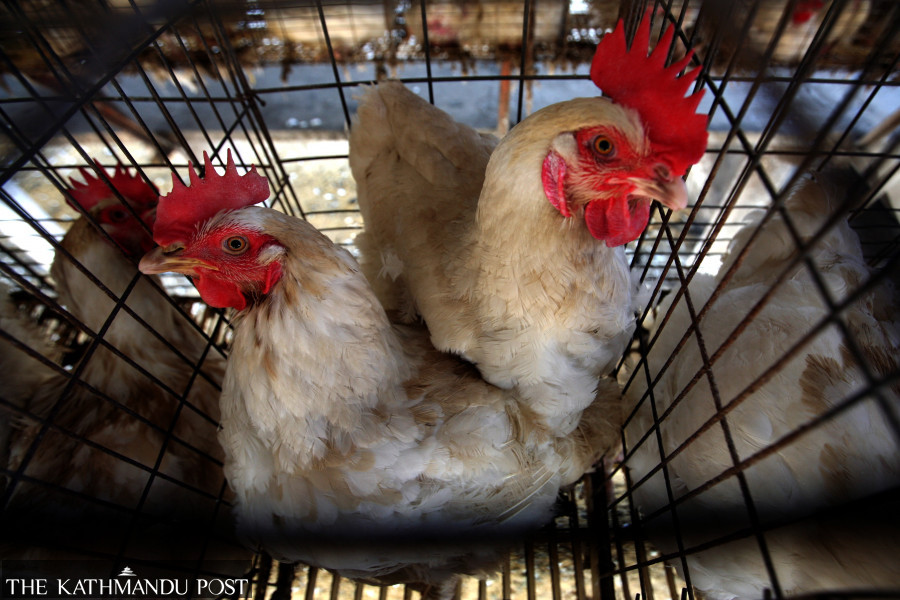National
Four days since bird flu detection, authorities yet to jump into action
Experts say complacency in handling highly contagious viruses could spell disaster in the country.
Arjun Poudel
Despite confirmation of A(H5N1), also known as bird flu or avian influenza virus, in the Lalitpur-based Nepal Agriculture Research Council’s turkey farm four days ago, authorities have yet to take measures to contain the spread of the contagioun.
The absence of Jwala Kumari Sah, minister for agriculture and livestock development, from Kathmandu is said to be the reason for the delay in taking a decision to cull the infected birds.
“Due to the absence of the minister in Kathmandu, it took time to approve the file,” an official at the Agriculture Ministry told the Post, asking not to be named as he feared retribution for speaking to the media. “Officials from agencies under the ministry went to Bara district on Friday to get the file approved from Minister Sah.”
H5N1 is a lethal bird flu virus strain that is highly pathogenic. The virus was first detected in birds in 2009 in Nepal.
Restriction in the movement to and from the infected poultry farm and culling all birds of the farm, disposal of dead and killed birds and manure are among the steps veterinary authorities should take immediately after the confirmation of the virus, experts say. And, taking days for such basic measures means the authorities concerned are not serious enough towards the risk, they added.
“We too do not understand why it takes days for authorities to kill the chicken and disinfect the farm after confirmation of an outbreak of virus,” said Dr Sital Kaji Shrestha, president of Nepal Veterinary Association. “More the time they take for basic measures, the more the loss there will be.”
Nepal had also reported a human death from the virus in 2019. A 21-year-old man from Kavrepalanchok district who was a driver by profession and used to drive poultry’s truck had died of a respiratory infection while undergoing treatment. The World Health Organisation (WHO) Collaborating Centre for Influenza in Japan had confirmed an infection of A(H5N1) in him after his death.
The first A(H5N1) infection in humans was reported in 1997 in Hong Kong and the virus has since spread to Asia, Africa, Middle East and Europe and other parts of the world, causing millions of poultry infections.
Although rare, confirmed human cases for bird flu as reported by the WHO from 2003 to November 25 last year stands at 868 human cases and 457 deaths with case fatality rate standing at 53 percent. According to the UN body, almost all cases of H5N1 infection have been associated with close contact with infected live or dead fowls or contaminated environment.
While the virus does not seem to be spreading from one human to another, a major concern among scientists is that the virus could mutate or combine with another influenza virus into something more infectious and result in a pandemic.
The World Organisation for Animal Health warned that a wave of bird flu in Asia and Europe has a greater risk of spreading to humans because of the high number of variants.
“This time, the situation is more difficult and riskier because we see more variants emerge, which make them harder to follow,” Reuters quoted Monique Eloit, director general of the World Organisation for Animal Health, as saying in an interview.
Officials at the Department of Livestock Services said that they have received samples of dead birds from several other poultry farms which have been sent to Central Veterinary Laboratory for bird flu testing.
“Until the reports come, we cannot say anything,” said Dr Chandra Dhakal, information officer at the department. “Outbreak of the virus has been confirmed at the Nepal Agriculture Research Council’s turkey farm and we are planning to deploy a team of veterinary technicians there on Sunday.”
When asked why the authorities took days to deploy a team and the risks involved in delaying taking the measures, Dhakal said that the minister’s approval is needed to cull the chicken, seal the area and provide compensation to the affected farmers.
In the case of Nepal Agriculture Research Council’s turkey farm, authorities do not have to compensate any farmer.
Nepal witnessed a massive bird flu outbreak in 2022 that saw outbreaks in 15 districts. Over 600,000 fowls were culled at the time. But authorities concerned have not yet provided compensation to the poultry farmers.
Hundreds of farmers who were involved in poultry farming gave up the profession due to the outbreak and are now struggling to get the compensation amounts for their birds that were culled by authorities.
“Authorities provide compensation to farmers only for the birds they culled,” said Shrestha, president of Nepal Veterinary Association. “Farmers will incur huge losses as they do not get compensation from authorities if the birds die themselves and a massive number of birds die after the outbreak of the virus.”
Experts say there is also a risk of the infected poultry reaching the market as some farmers may sell their fowls to cut their losses.
“Chances of spread of the infection will increase when authorities take more time to contain it,” Shrestha said. “Complacency in handling highly contagious viruses can invite another disaster.”




 7.47°C Kathmandu
7.47°C Kathmandu










%20(1).jpg&w=300&height=200)




